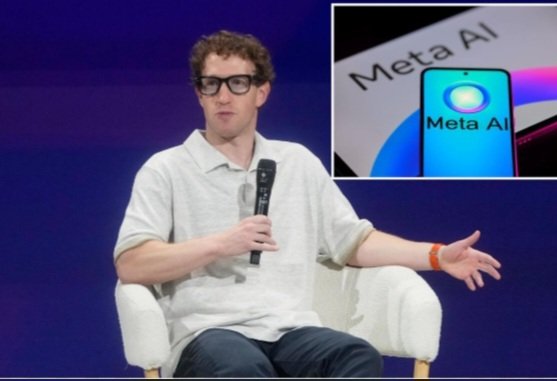Mark Zuckerberg’s ambitious vision for the development of artificial intelligence came crashing down in April.
The 41-year-old CEO of Meta had boasted in public a few weeks prior that his company’s new artificial intelligence (AI) model, which would power the newest chatbots and other innovative trials, would be a “beast.” According to sources who met with Mr. Zuckerberg, he told staff members that he wanted it to be able to drive features like voice-powered chatbots and compete with rivals like OpenAI’s A.I. systems.
However, the new A.I. model did not perform as well as competitors at Meta’s A.I. conference that month. Voice interactions and other features were not yet ready. Many developers who had great hopes for the event were disappointed.
According to some close to Mr. Zuckerberg, he was aware that Meta was lagging behind in artificial intelligence, which was unacceptable. He started planning his course of action in a WhatsApp group with senior executives, such as Andrew Bosworth, the chief technology officer, and Chris Cox, Meta’s head of product.
This sparked a flurry of activity that has spread throughout Silicon Valley. The vice president of Meta who oversaw generative AI was demoted by Mr. Zuckerberg. He then hired Alexandr Wang, the 28-year-old creator of Scale AI, and invested $14.3 billion in the startup. Meta inquired into deals with other start-ups, such as Perplexity, an AI search engine. Additionally, according to two people with knowledge of the situation, Mr. Zuckerberg and his associates have gone on a hiring rampage, contacting over 45 artificial intelligence experts at rival OpenAI alone this month and offering them compensation packages as high as $100 million apiece. The corporation has extended offers to four OpenAI researchers.
According to two people familiar with the conversations, Mr. Zuckerberg and his lieutenants talked about “de-investing” in Meta’s A.I. model, Llama, in yet another unprecedented move. Since its core technology is freely available for others to build upon, Llama is a “open source” model. Instead, Mr. Zuckerberg and executives from Meta talked about adopting artificial intelligence models from rivals with “closed” code bases, such as OpenAI and Anthropic. On the subject, no final judgments have been taken.
According to a Meta representative, the business “remains fully committed to developing Llama and plan to have multiple additional releases this year alone.”
In an extremely ambitious competition that has arisen within the larger A.I. fight, Mr. Zuckerberg has increased his efforts to keep Meta competitive. He is pursuing “superintelligence,” or artificial intelligence (A.I.) that is more potent than the human brain and is a potentially divine technology. According to those close to him, Mr. Zuckerberg wants to make sure that Meta is included in the small group of Silicon Valley businesses that are thought to have the expertise to achieve this: OpenAI, Anthropic, and Google.
“He is similar to many C.E.O.s at large tech companies who are telling themselves that artificial intelligence (AI) is going to be the biggest thing they have ever seen, and they will be left behind if they don’t figure out how to become a big player in it,” said Matt Murphy, a partner at Menlo Ventures, a venture capital firm. “Anything to avoid that is worth it,” he continued.
To seize future innovation that they estimate will be worth trillions of dollars, executives at rival digital giants are likewise going to great lengths. To stay competitive, Google, Microsoft, and Amazon have increased their investments in artificial intelligence. Additionally, the talent war has surged, pushing AI experts into the same pay range as NBA players.
According to two people with knowledge of the methods, hiring researchers is a personal responsibility of Microsoft and OpenAI CEOs Satya Nadella and Sam Altman, as well as Google CEO Sundar Pichai and his top A.I. lieutenant Demis Hassabis. A.I. technologists are being offered multimillion-dollar contracts by some big corporations over email without even conducting an interview.
“In my 20-year career as a technology executive, the market is setting a rate here for a level of talent which is really incredible, and kind of unprecedented,” Mr. Bosworth of Meta stated in a CNBC interview last week. According to him, Meta had attempted to hire several of the individuals who had received counteroffers from Mr. Altman.
Google and OpenAI choose not to comment. The Information and Bloomberg have already covered some of the specifics of Meta’s initiatives.
Microsoft and OpenAI have been sued by The New York Times for allegedly violating the copyright of news articles about artificial intelligence (AI) technologies. Microsoft and OpenAI have refuted those assertions.)
Meta seems to stay up with the A.I. race for years. Yann LeCun, regarded as a pioneer of modern artificial intelligence, was employed by Mr. Zuckerberg more than ten years ago. FAIR, or Fundamental AI Research, was co-founded by Dr. LeCun and later became Meta’s artificial intelligence research division.
In response to OpenAI’s 2022 release of its ChatGPT chatbot, Meta established a generative artificial intelligence team the next year, led by Ahmad Al-Dahle, one of its executives, to integrate the technology across the company’s products. In order to solidify its technology and promote the advancement of artificial intelligence, Meta also made its models publicly available by providing the underlying computer code.
However, as Google and OpenAI developed AI chatbots that could look, hear, and speak, and introduced AI systems that could “reason,” Meta found it difficult to follow suit. One explanation was that the business lacked experience with “reinforcement learning,” a method that other companies were employing to create artificial intelligence.
The Chinese start-up DeepSeek published A.I. models late last year that were based on Llama but were more sophisticated and needed less development resources. Once thought to be a competitive advantage, Meta’s open-source approach seemed to have given others an advantage.
Mr. Zuckerberg was aware that he had to take action. According to two people involved with the outreach, he started sending emails to outside A.I. experts at that time, asking whether they would be interested in joining Meta.
With the release of two updated Llama models in April, Meta claimed that the models outperformed similar models from Google and OpenAI. Meta used its own testing benchmarks to support its assertion. Mr. Zuckerberg promoted the releases on Instagram with a video selfie.
However, a few independent researchers soon concluded that Meta’s benchmarks were set up to make one of its models appear more sophisticated than it actually was. They were furious.
According to sources with knowledge of the situation, Mr. Zuckerberg later discovered that his artificial intelligence team had intended the models to seem to perform well, even though they weren’t performing as well as anticipated. According to two people, Mr. Zuckerberg was unhappy at not being informed about the personalized testing.
Adding additional bodies to the problem was his solution. This year, Meta’s A.I. section grew from a few hundred two years ago to over 1,000 employees.
The quick expansion resulted in managerial disputes and internal strife. And because of Mr. Zuckerberg’s relentless, hard-charging managerial style—his focus on a project is frequently likened internally to the “Eye of Sauron,” a reference to the villain from “Lord of the Rings”—some engineers burnt out and quit. Executives gathered to discuss possible next actions, such as reducing investment in Llama.
Mr. Zuckerberg pushed Mr. Al-Dahle aside in May and accelerated hiring of leading artificial intelligence (AI) researchers to head a superintelligence lab. With his checkbook in hand, Mr. Zuckerberg continued to contact and email potential applicants, inviting them to meet at Meta’s Menlo Park, California, headquarters. Mr. Zuckerberg frequently uses an enclosed glass conference room, sometimes referred to as “the aquarium,” for recruitment meetings.
According to two persons familiar with the discussions, part of the outreach involved discussing an acquisition with Perplexity. No agreement has been reached. According to two people familiar with the strategy, Mr. Zuckerberg also discussed joining Meta with Ilya Sutskever, a prominent A.I. researcher and former head scientist of OpenAI. Safe Superintelligence’s founder, Dr. Sutskever, turned down the overture. A request for comment from him was not answered.
However, Mr. Wang of Scale, a company that uses data to train artificial intelligence systems, was won over by Mr. Zuckerberg. They were introduced by friends and are further connected by Elliot Schrage, a former Meta executive who advises Mr. Wang and invests in Scale.
In order to assist in managing the superintelligence lab, Meta said this month that it would acquire a minority investment in Scale and hire Mr. Wang, who is not recognized for having extensive technical knowledge but has numerous ties in the A.I. community, along with a number of his top executives.
According to a person with knowledge of the discussions, Meta is currently in negotiations to join Safe Superintelligence with Daniel Gross, its CEO, and Nat Friedman, his financial partner. Requests for comment were not answered.
Meta has a lot of work ahead of it. According to several AI scholars, Mr. Zuckerberg has not explicitly stated his AI goals beyond attempting to maximize digital advertising. Others argued that the next A.I. superpower shouldn’t be developed in Meta.
According to insiders, the competitive landscape for technological talent has irreversibly shifted, regardless of Mr. Zuckerberg’s success.
The CEO of the artificial intelligence start-up Replit, Amjad Masad, used a word for exceptionally prolific workers to say, “In Silicon Valley, you hear a lot of talk about the 10x engineer.” Some of these AI researchers can be compared to 1,000x engineers. It’s worth it if you can hire one person who has the power to alter the course of your entire business.





